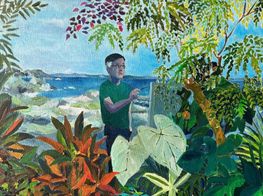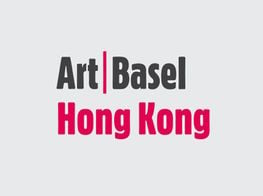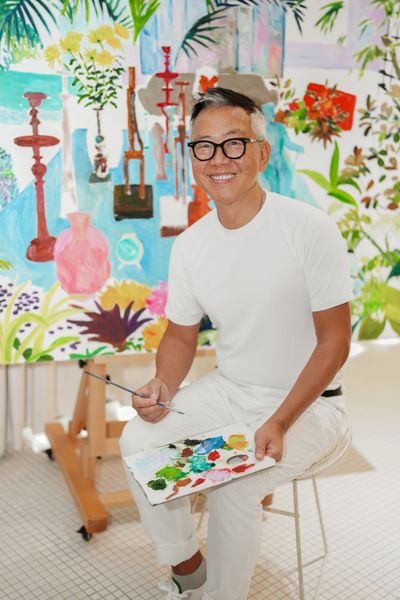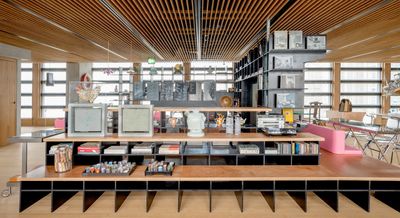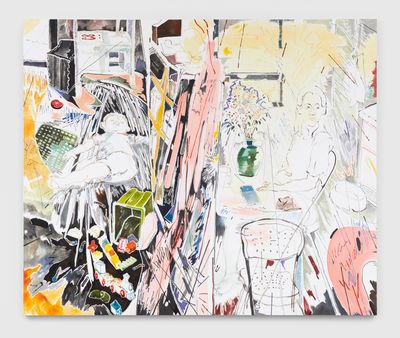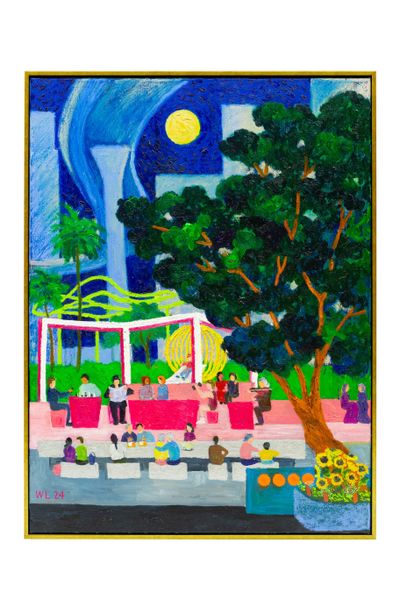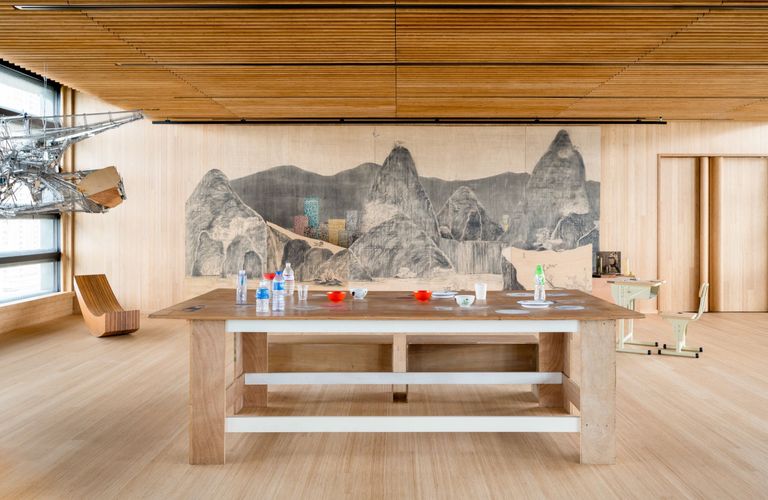
Hong Kong Through the Eyes of William Lim
Most of us catch the latest Hollywood blockbuster. Some restart the book they've been trying to read since Christmas. Fewer, I'm sure, spend a 20-hour flight setting up a mini art studio like William Lim does.
Lim is an architect, art collector, and artist. His Hong Kong-based practice, CL3 Architects, is responsible for H Queen's tower in Central and the interiors of Singapore's Marina Bay Sands, among a number of Asia's most iconic art-led designs.
Leveraging their success, William Lim and his wife, interior designer Lavina, have built the largest private art collection in Hong Kong. In 2021, they donated a large portion of their 'Living Collection' to M+, the museum of contemporary Asian visual culture located in Hong Kong's West Kowloon Cultural District.
Lim began painting—a practice he refined on long-haul flights—during the Covid-19 pandemic in 2020. This passion, along with his architectural background, informs Lim's eye when he scours the halls of Hong Kong's exhibitions and art fair halls for works to collect.
Gearing up for Art Basel Hong Kong (28–30 March 2024), Ocula Director Rory Mitchell spoke with Lim about the Hong Kong artists on his radar, his aeroplane art studio, and the best places to see art in the city.
In 2014, you published the book The No Colors, which focused on Hong Kong artists. What three Hong Kong artists have recently interested you and why?
Li Ning is a print artist and professional tattoo artist. He makes unique prints from repeated images that are drawn by hand. They combine the imagery of movies with that of Japanese woodblock prints. They're also getting larger; some are two metres long.
Movana Chen is slightly more established. She lived in Hong Kong but is now based in Lisbon, Portugal. Her sculptures are constructed by weaving shredded paper strips from books, magazines, or maps—usually materials she encounters while travelling. Her monumental installation Knitting Conversations (2013), reflecting on female labour, and personal and shared memories, was recently on view at M+.
Jacky Tao has a more traditional approach compared to Li Ning in terms of using Chinese ink with colour. Many of the scenes he depicts are local to Hong Kong: markets, locals, or the Mass Transit Railway (MTR). I like the way he combines gongbi—a very refined, realist Chinese painting technique—with contemporary cityscapes.
What was the last show you visited that truly impressed you?
I just got back from the Biennale of Sydney (9 March–10 June 2024), which I thought was brilliant. This year they unveiled White Bay Power Station as the Biennale's new venue; a decommissioned power station on Sydney Harbour, which felt cavernous and raw.
The 24th edition, Ten Thousand Suns, dealt with the cosmos, ethnicity, and colonialism. Many artists presented works that weaved between contemporary and primitive-looking objects, which looked fantastic interacting with this industrial, colonial building.
Another is the exhibition Shanshui: Echoes and Signals that recently opened at M+ in Hong Kong (3 February 2024–31 July 2026). The exhibition reimagines shanshui (traditional Chinese landscape painting) through contemporary art and design.
The museum incorporated installations by Isamu Noguchi among other modern and contemporary artists, alongside more traditional Chinese paintings by artists such as Zao Wou-Ki, Guo Hongwei, and Yang Jiechang.
When M+ started, the museum primarily showed works that were in their collection. Whereas now, they are creating more ambitious exhibitions outside of their collection, and so far, it's been well executed.
Hong Kong has very strong artists. Chris Huen Sin Kan, Nadim Abbas, Angela Su, and Trevor Yeung come to mind. Do you consider Hong Kong artists to be sufficiently represented in M+ and by galleries in the city?
The contemporary art scene in Hong Kong started around 2000 when the Hong Kong Art School started teaching contemporary art.
Surprisingly, it was not part of the curriculum before; many contemporary artists were only trained within the last 20 years. For the majority, it could be less than 10 years. So while M+ actively collects Hong Kong artists, it may take time before the collection is substantial.
However, one of the biggest donations M+ received was from Swiss collector Uli Sigg, who donated over 1,000 works by mainland Chinese artists.
Who was among this first cohort who graduated Hong Kong Art School?
Lee Kit, Lam Tung-Pang, Tsang Kin-Wah, and Tozar Pak were all part of this early cohort. The generation of artists before mostly became academics. And before that, it's really the ink artists.
You are also an artist. Can you tell us about your practice?
I'm an architect in training, but I have always liked art. It wasn't until the Covid-19 lockdown that I started painting regularly. I would paint the view from my window and possessions scattered around the house. These subjects became synonymous with the isolation and trappings that we all felt throughout this time.
After the lockdown, I was encouraged to continue and have been painting for the last four years. Last year, I had the opportunity to show a series of my works with Grotto Fine Art at Art Basel Hong Kong, and this year, with Ora-Ora at Basel and Touch Gallery at Art Central.
My medium is oil paint and it's all figurative. It's a way for me to record my life, a diary of sorts, of my family and the places I travel to.
When you travel, do you paint from memory and observation, or are your paintings rendered later from photographs?
When I travel, the minimum I bring is a box of oil pastels. I most enjoy drawing on aeroplanes, especially long-haul flights, where I will set up a mini studio in my seat and bring out my oil pastels and paper pads.
When I went to Sarawak in Malaysia the other day, I bought a set of canvases with me and managed to capture fleeting moments like a storm rolling in over the mountains.
Trevor Yeung, whose work you collect, is representing Hong Kong at the Venice Biennale this year and showing work at the Biennale of Sydney. What draws you to his work?
Trevor's work has always been very interesting to me; I've followed him from the beginning of his artistic career, about seven or eight years ago. At the time, he worked pretty much full-time at Para Site and was beginning to exhibit at local galleries.
His early work had this voyeuristic quality. At the time, he travelled and stayed in youth hostels where he photographed people he encountered. The works he produced became portals into how Trevor looked at and fantasised about these people. This was before he incorporated plants into the more installation-type work we see today.
I think the idea of dealing with reality while hiding emotional elements within him is very interesting. It's great to see an artist whom you've followed representing Hong Kong at the Venice Biennale 2024. Part of my donation to M+ included his works.
Can you talk about your contribution to M+?
Before donating our collection to M+, we kept our collection in a 5,000-square-foot studio space in Hong Kong where we'd invite people for dinners and host social gatherings.
So over the years, many art curators, collectors, and museum people came to see the collection of Hong Kong artists on their visits to Hong Kong. Eventually, I thought it would be meaningful if this collection was visible to more people, especially locals.
When you visit M+ is there a particular artwork you donated that you find yourself going back to?
Of course, there are a few works that are very dear. One is a work by Lam Tung-Pang, one of the founders of the Fotanian art movement in Hong Kong, placed at the far end of the M+ lounge. It's a large work on plywood that combines traditional Chinese painting—the basis of which is a landscape from a Song dynasty painting—painted over with imagery of a contemporary Hong Kong cityscape.
You've spoken about how Donald Judd would be a dream work to own. Why?
My training is in architecture so I love artworks that combine spatial treatment and art. As an artist, Judd was very interested in architecture, and for that reason [his work] is executed with a similar precision to an architect's, especially his furniture. They're a cross between functional and non-functional—something that can be experienced.
Where should people see Hong Kong art outside the fair, M+, and the major galleries?
Since Covid-19, interesting venues have opened in Hong Kong. One in particular is Tai Kwun, which is a complex of buildings housing restaurants and a handful of art galleries in the former Central Police Station. It's very convenient to visit and a great place to understand Hong Kong in terms of its history and experiences, culture, food, and art.
The group exhibition Green Snake: Women-Centred Ecologies at Tai Kwun Contemporary (20 December 2023–1 April 2024) is a good place to start. —[O]
Main image: Living Collection in M+ Lounge, Hong Kong. Courtesy CL3 Architects.

